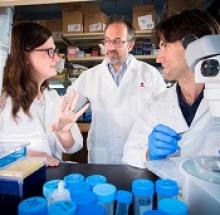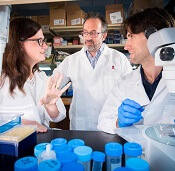User login
Life-long hematopoiesis relies on hundreds more blood progenitors than previously reported, according to preclinical research published in Nature Cell Biology.
Previous studies linked life-long mammalian blood production to just a handful of precursor cells that emerge during prenatal development.
In the current study, researchers found that, in mice, roughly 600 to 700 developmental precursors contribute to life-long hematopoiesis.
The number of precursor cells in humans is likely at least 10 times greater, according to researchers.
“All previous studies had reported that very few precursor cells are involved in establishing the blood system,” said study author Shannon McKinney-Freeman, PhD, of St. Jude Children’s Research Hospital in Memphis, Tennessee.
“But data in this study show that, actually, hundreds of cells are involved and that the developing blood system is more complex and may be shaped, in part, by regulatory bottlenecks that occur late in development and serve to restrict the number of blood-forming stem cells.”
For this study, Miguel Ganuza, PhD, a fellow in Dr McKinney-Freeman’s lab, adapted a system used to study the cellular makeup of solid tumors. The multi-colored labeling system is activated by genes expressed during specific windows of development.
Dr Ganuza used the system to label and track the fate of precursor cells from various developmental stages in mice.
“We wanted to understand what was happening with different progenitor cells at different stages of development when we knew important decisions on the fate of cells occurred,” Dr Ganuza said.
David Finkelstein, PhD, of the St. Jude Department of Computational Biology, then used mathematical modeling to work backward from peripheral blood in adult mice to track the contribution of precursor cells from the early, middle, and late stages of prenatal development.
The results showed that far more precursor cells than expected contribute to life-long hematopoiesis in adult mice.
The researchers found about 719 Flk1+ mesodermal precursors emerged at embryonic days 7 to 8.5, 633 VE-cadherin+ endothelial precursors emerged at embryonic days 8.5 to 11.5, and 545 Vav1+ nascent hematopoietic stem and progenitor cells emerged at embryonic days 11.5 to 14.5.
The team also said specification of hemogenic endothelial cells begins at embryonic day 8.5 and ends by embryonic day 10.5. After that, it cannot be reactivated.
Finally, the researchers found that intra-aortic hematopoietic clusters are polyclonal in origin.
The team said these findings raised questions about the role of the fetal liver in hematopoiesis.
“For decades, the fetal liver was thought to be where the number of blood stem cells expanded dramatically,” Dr McKinney-Freeman said.
“The results in this study raise questions about that model and even suggest the presence of developmental bottlenecks in the fetal liver or at later stages of development that restrict the blood stem cell population. This is when science is most interesting, when you see things you didn’t expect.”
While unexpected, the newly revealed size and complexity of the emerging blood system make sense developmentally, Dr McKinney-Freeman said.
“Producing hundreds of progenitor cells during different developmental stages means the organism has greater flexibility to adapt to issues and problems that might emerge as development progresses,” she noted.
The findings also have clinical implications, according to Dr McKinney-Freeman.
“Understanding how the blood system emerges, including the number and complexity of the progenitor cells involved, will help us unravel the origins of disease and identify cells that might be susceptible to disease-causing mutations,” she concluded. ![]()
Life-long hematopoiesis relies on hundreds more blood progenitors than previously reported, according to preclinical research published in Nature Cell Biology.
Previous studies linked life-long mammalian blood production to just a handful of precursor cells that emerge during prenatal development.
In the current study, researchers found that, in mice, roughly 600 to 700 developmental precursors contribute to life-long hematopoiesis.
The number of precursor cells in humans is likely at least 10 times greater, according to researchers.
“All previous studies had reported that very few precursor cells are involved in establishing the blood system,” said study author Shannon McKinney-Freeman, PhD, of St. Jude Children’s Research Hospital in Memphis, Tennessee.
“But data in this study show that, actually, hundreds of cells are involved and that the developing blood system is more complex and may be shaped, in part, by regulatory bottlenecks that occur late in development and serve to restrict the number of blood-forming stem cells.”
For this study, Miguel Ganuza, PhD, a fellow in Dr McKinney-Freeman’s lab, adapted a system used to study the cellular makeup of solid tumors. The multi-colored labeling system is activated by genes expressed during specific windows of development.
Dr Ganuza used the system to label and track the fate of precursor cells from various developmental stages in mice.
“We wanted to understand what was happening with different progenitor cells at different stages of development when we knew important decisions on the fate of cells occurred,” Dr Ganuza said.
David Finkelstein, PhD, of the St. Jude Department of Computational Biology, then used mathematical modeling to work backward from peripheral blood in adult mice to track the contribution of precursor cells from the early, middle, and late stages of prenatal development.
The results showed that far more precursor cells than expected contribute to life-long hematopoiesis in adult mice.
The researchers found about 719 Flk1+ mesodermal precursors emerged at embryonic days 7 to 8.5, 633 VE-cadherin+ endothelial precursors emerged at embryonic days 8.5 to 11.5, and 545 Vav1+ nascent hematopoietic stem and progenitor cells emerged at embryonic days 11.5 to 14.5.
The team also said specification of hemogenic endothelial cells begins at embryonic day 8.5 and ends by embryonic day 10.5. After that, it cannot be reactivated.
Finally, the researchers found that intra-aortic hematopoietic clusters are polyclonal in origin.
The team said these findings raised questions about the role of the fetal liver in hematopoiesis.
“For decades, the fetal liver was thought to be where the number of blood stem cells expanded dramatically,” Dr McKinney-Freeman said.
“The results in this study raise questions about that model and even suggest the presence of developmental bottlenecks in the fetal liver or at later stages of development that restrict the blood stem cell population. This is when science is most interesting, when you see things you didn’t expect.”
While unexpected, the newly revealed size and complexity of the emerging blood system make sense developmentally, Dr McKinney-Freeman said.
“Producing hundreds of progenitor cells during different developmental stages means the organism has greater flexibility to adapt to issues and problems that might emerge as development progresses,” she noted.
The findings also have clinical implications, according to Dr McKinney-Freeman.
“Understanding how the blood system emerges, including the number and complexity of the progenitor cells involved, will help us unravel the origins of disease and identify cells that might be susceptible to disease-causing mutations,” she concluded. ![]()
Life-long hematopoiesis relies on hundreds more blood progenitors than previously reported, according to preclinical research published in Nature Cell Biology.
Previous studies linked life-long mammalian blood production to just a handful of precursor cells that emerge during prenatal development.
In the current study, researchers found that, in mice, roughly 600 to 700 developmental precursors contribute to life-long hematopoiesis.
The number of precursor cells in humans is likely at least 10 times greater, according to researchers.
“All previous studies had reported that very few precursor cells are involved in establishing the blood system,” said study author Shannon McKinney-Freeman, PhD, of St. Jude Children’s Research Hospital in Memphis, Tennessee.
“But data in this study show that, actually, hundreds of cells are involved and that the developing blood system is more complex and may be shaped, in part, by regulatory bottlenecks that occur late in development and serve to restrict the number of blood-forming stem cells.”
For this study, Miguel Ganuza, PhD, a fellow in Dr McKinney-Freeman’s lab, adapted a system used to study the cellular makeup of solid tumors. The multi-colored labeling system is activated by genes expressed during specific windows of development.
Dr Ganuza used the system to label and track the fate of precursor cells from various developmental stages in mice.
“We wanted to understand what was happening with different progenitor cells at different stages of development when we knew important decisions on the fate of cells occurred,” Dr Ganuza said.
David Finkelstein, PhD, of the St. Jude Department of Computational Biology, then used mathematical modeling to work backward from peripheral blood in adult mice to track the contribution of precursor cells from the early, middle, and late stages of prenatal development.
The results showed that far more precursor cells than expected contribute to life-long hematopoiesis in adult mice.
The researchers found about 719 Flk1+ mesodermal precursors emerged at embryonic days 7 to 8.5, 633 VE-cadherin+ endothelial precursors emerged at embryonic days 8.5 to 11.5, and 545 Vav1+ nascent hematopoietic stem and progenitor cells emerged at embryonic days 11.5 to 14.5.
The team also said specification of hemogenic endothelial cells begins at embryonic day 8.5 and ends by embryonic day 10.5. After that, it cannot be reactivated.
Finally, the researchers found that intra-aortic hematopoietic clusters are polyclonal in origin.
The team said these findings raised questions about the role of the fetal liver in hematopoiesis.
“For decades, the fetal liver was thought to be where the number of blood stem cells expanded dramatically,” Dr McKinney-Freeman said.
“The results in this study raise questions about that model and even suggest the presence of developmental bottlenecks in the fetal liver or at later stages of development that restrict the blood stem cell population. This is when science is most interesting, when you see things you didn’t expect.”
While unexpected, the newly revealed size and complexity of the emerging blood system make sense developmentally, Dr McKinney-Freeman said.
“Producing hundreds of progenitor cells during different developmental stages means the organism has greater flexibility to adapt to issues and problems that might emerge as development progresses,” she noted.
The findings also have clinical implications, according to Dr McKinney-Freeman.
“Understanding how the blood system emerges, including the number and complexity of the progenitor cells involved, will help us unravel the origins of disease and identify cells that might be susceptible to disease-causing mutations,” she concluded. ![]()

